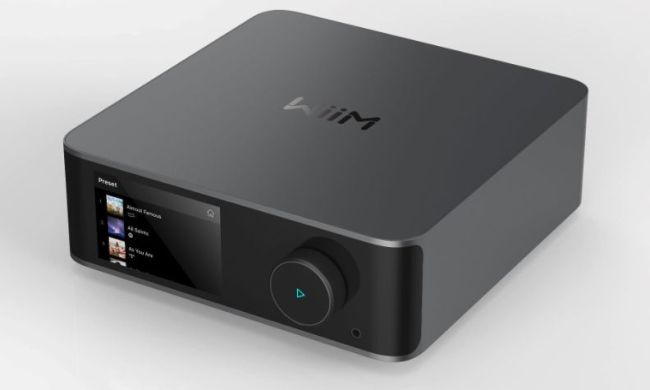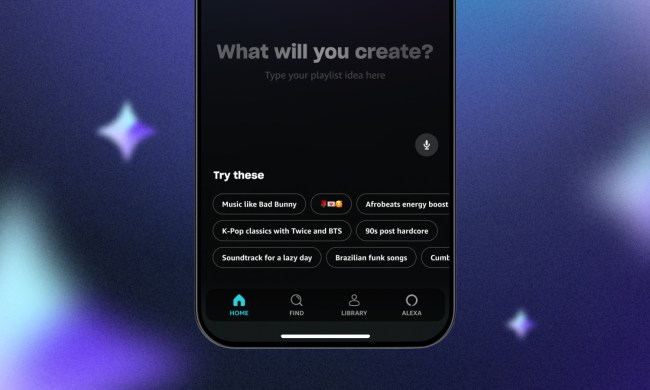
Taking your music with you used to be as easy as popping the cassette out of your home tape player and into your car, boombox, or Walkman. Not so any more. Though the rise of the MP3 has made it possible to download albums in seconds, share them with your friends, and fit millions of songs in a single box, the actual process of getting it from off a desktop hard drive and playing it somewhere else has taken a step backward in simplicity. But that’s quickly changing, as a plethora of services and gadgets have sprung up to fill the void. Leave Bon Jovi at home no more. Let’s take a look at some of the ways you can get your music off your desktop.
Living Room
Unless you home computer happens to be conveniently located next to your stereo receiver, filling your home with the sweet sounds of Weezer is usually a little more complicated than just stringing a cable from one box to the other. A dedicated home theater PC (HTPC) will do the job, but it’s really overkill for the simple task of pulling audio files over a network. Enter the home media streamer: a device designed solely to connect to a network and play music.
Logitech and Sonos make two of the most popular (and expensive) streaming audio solutions. Logitech’s $299 Squeezebox Classic uses an existing Wi-Fi network to pull all your existing MP3s over, translates them to the analog signal your stereo will understand with a high-quality 24-bit Burr-brown DAC, and output them via standard RCA, digital optical, or digital coax outputs. If you don’t have a collection of MP3s, it also works with the free Pandora and Slacker services, and with paid subscriptions to Sirius and Rhapsody. Sonos uses its own mesh-networking approach to send digital audio, which unfortunately means more pieces to buy, but the consensus seems to be that the quality and style of its units makes up for the price, if you can afford it. A $349 ZonePlayer 90 and $349 Controller 200 are technically all you need to get started, but iPod and iPhone users can install an app to substitute for the controller, in a pinch. A $100 ZoneBridge may also be necessary to link the ZonePlayer to your network wirelessly, if you can’t run Ethernet cables to the Player itself. Sonos supports Pandora but not Slacker, as well as Napster, Sirius and Rhapsody. Philips’s $229 Streamium NP2500 player is one of the most affordable on the market, but we found the small display and lack of support for Pandora and Slacker offputting.

If you’re lucky enough to have an Xbox 360 or PlayStation 3 in your home entertainment system, those systems can also easily serve as streaming audio centers. Check out our guides to setting up your Xbox 360 or PlayStation 3 as a home media server.
Bedroom
Getting music to your bedroom is really no more difficult than a living room, save for one important distinction: You probably don’t already have an amplifier and speakers sitting around and ready to go. If you do, any of the products suitable for the living room are also fine. If you don’t, check out some of the more specialized solutions out there.
Logitech’s $299 Squeezebox Boom combines the streaming capabilities of the Classic with a built-in amplifier and speakers. The Boom captured our accolades for its ease of use, build quality, and sound quality, which is surprisingly rich for such a small unit. It even has alarm clock features to replace your bedside clock radio. The $499 Sonos ZonePlayer 120 rolls a built-in digital amp to the features of the ZonePlayer 90, but you’ll still need to furnish your own speakers. With 55 watts of sound on tap for each channel, though, it certainly has the potential to pound out a lot more sound than the Boom. If you plan to listen to Internet radio alone, Sanyo’s $200 R227 will tap into thousands of them for free, includes built-in speakers, and unlike the Boom, plays FM radio as well.

Car
Nothing is more frustrating than a glove box full of scratched up CDs you’ve listened to a dozen times and an iPod full of fresh tunes… that you can’t get through to the car stereo. Fortunately, there are plenty of gadgets to get them blasting.
If your car has a cassette player, a simple cassette adapter like this Belkin model makes one of these easiest ways to pipe tunes into the stereo. It may not be CD quality, but the ease of popping in a the adapter, attaching your MP3 player and pressing play can’t be beat. If you have a newer car with only a CD player, or for that matter, one so old it predates cassettes, an FM transmitter makes a great second choice. It will take the output from your player and rebroadcast it as a mini FM station on the frequency of your choice, so you can tune the car radio to it and listen. Monster’s $60 RadioPlay 300 makes a great choice for generic MP3 players since it uses the standard 3.5mm stereo jack, but iPod owners should invest in an iPod-specific adapter, like the $100 iCarPlay Wireless 1000, because it will offer controls and charging. Unfortunately, even the best transmitters sometimes struggle in cities, where packed airwaves make it difficult to find a vacant frequency to broadcast on without interference.

Not looking to retrofit your existing stereo, and ready to invest in a 21st century head unit? Many new car stereos now offer USB ports to pop in a thumb drive full of tunes, auxiliary audio jacks to connect MP3 players with a simple stereo cable, and even built-in hard drives. Our guide to car and auto technology outlines a few of the best choices in each category, including dedicated carputers.
Cell Phone
If you own a modern cell phone, you own an MP3 player. Though media-playing capabilities vary by model, almost all phones made within the past few years will play basic MP3 files. You can either load your collection onto the phone’s internal memory by connecting it via a USB cable, or add songs through an additional memory slot by inserting a microSD card. Lately, plummeting memory prices have made the second option far more viable: You can pick up a 16GB microSD card for around $45, turning a compatible cell phone into legit player with a single affordable purchase.
Smartphones with data connections make even more capable music players. Rather than relying on your personal MP3 collection, you can take advantage of many of the same popular streaming services that you might use on a desktop computer. Pandora, Slacker and Last.fm all offer iPhone apps, and many offer their services on other platforms (like BlackBerrys) as well. That translates to unlimited free music at your fingertips as long as you have ample cell reception.
At Work
A common dilemma: You have about 392 solid days worth of audio files on your computer at home, but as soon as you trudge to work, enter your humorless cubicle and sit down at your workstation, you’re stuck in a music-less vacuum. This one’s an easy fix.
First, consider all the free options out there, including services we’ve already mentioned like Pandora, Slacker and Last.fm. Add thousands of free streaming Internet radio stations into the mix, accessible via sites like Live365, Shoutcast and Yahoo! Music, and you’re looking at a lot of content already out there just waiting to be seized.
If you’re really pining for your collection, though, consider downloading software that will turn your home computer into a streaming audio server, serving up tunes to anywhere with an Internet connection. Logitech’s SqueezeCenter (formerly known as SlimServer) will do the task in conjunction with Logitech’s Squeezebox gadgets, or with an ordinary PC using the Web-based SqueezeCenter interface. The result: your entire library of music at home is now accessible from work, a hotel room, or anywhere, for that matter. Of course, you’ll need to leave the home PC running all the time for it to grab the files.
For those who would rather not commit to running a home computer 24/7, or clog up two different Internet connections at once with the burden of streaming it, a portable hard drive makes a lot of sense, as simple as it may seem. Savvy consumers can easily score 1TB external drive now for under $100, which should be big enough to fit all but the most grotesque overgrown music collections.



